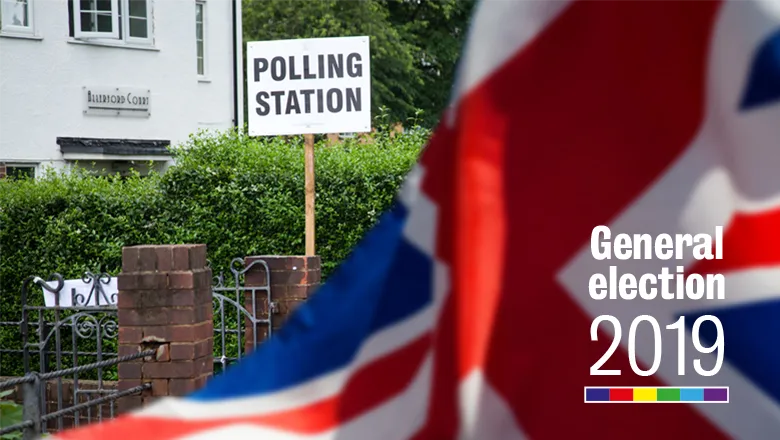09 December 2019
Polarisation during the general election campaign
Brexit identities have grown stronger, and opposing groups have very negative views of each other

New analysis by the Policy Institute at King’s College London reveals the extent of divisions in Britain during the 2019 general election campaign.
Using data from a survey of over 2,000 adults aged 18-75 conducted between 27 and 29 November, the analysis finds that people’s Brexit identities have grown stronger, that opposing groups have very negative views of each other and the two main parties’ leaders, and that there are widespread misperceptions about how the “other side” feels about important political issues such as the NHS.
Download the full report for charts and detailed analysis
Brexit and political party identities
- In this general election campaign, the British public’s Brexit identities are dramatically stronger than their political party identities. 22% say they identify very strongly with their party, while more than double – 55% – say they identify very strongly with their side of the Brexit debate.
- The proportion who very strongly identify with their side of the Brexit debate has increased, from 44% in 2018 to 55% today.
- Over the same period, the proportion who very strongly identify with their political party has also increased, from 9% to 22% – which is likely to reflect that we’re in an election campaign
The two main parties
- Conservatives (28%) and Labour supporters (27%) very strongly identify with their respective parties to virtually the same extent.
- Leave (63%) and Remain supporters (61%) also very strongly identify with their side of the Brexit debate to almost exactly the same extent
Other parties
- The Lib Dems and Green Party have the lowest proportion of supporters who say they very strongly identify with their parties – both at just 13%.
- By contrast, strength of identification with a political party is highest among SNP supporters, 45% of whom say they very strongly identify with the party.
How opposing sides feel about each other
Asking groups to rate the opposing side on a “feeling thermometer”, from 0 (coldest) to 100 (warmest), reveals:
Conservatives vs Labour
- Supporters of the two main parties rate each other almost equally negatively: Labour supporters give Conservatives a 15 out of 100, while Conservatives give Labour supporters an 18.
- Labour supporters feel more negatively towards Jeremy Corbyn (49) than Conservative supporters do towards Boris Johnson (62).
Comparison with divisions in 2016 US election
- These ratings are more negative than the scores Republicans and Democrats gave each other in the run-up to the 2016 US presidential election. Then, Republicans rated Democrats 29 out of 100, while Democrats rated Republicans at 31.
- Jeremy Corbyn is rated lower by Conservatives (5) than Hillary Clinton was by Republicans in 2016 (12).
- Boris Johnson is rated only slightly more positively by Labour supporters (13) than Donald Trump was by Democrats in 2016 (11).
Leave vs Remain
- Leave supporters give Remain voters a thermometer rating of 23, while Remainers give Leavers a slightly more negative rating of 19.
- Leave supporters have a much warmer view of Boris Johnson (56) than Remain supporters have of Jeremy Corbyn (37).
Opposing sides’ misperceptions about each other
The NHS
- 90% or more of the two main parties’ supporters, as well as both Leavers and Remainers, all agree the NHS is crucial to British society and we must do everything we can to maintain it.
- But people who don’t identify with these groups significantly underestimate levels of support for this view among them. The biggest gap in perception is for the Tories: non-Conservatives guess 56% of Tories hold this view of the NHS, when 90% actually do.
Climate change denial
- People significantly overestimate the proportion of Leavers, Remainers, Conservatives and Labour supporters who agree that global warming is an expensive hoax.
- The guesses are around twice as high as the actual level for each group: for example, 21% of Leave supporters think global warming is a hoax, but the average guess from non-Leavers is 40%. More people think climate change is genuine than we realise.
Leaving the EU without a deal
- People are more accurate at guessing levels of support for a no-deal Brexit among the four groups.
- However, those who do not identify with the Labour Party overestimate the proportion of Labour supporters who favour a no-deal Brexit by 11 percentage points, guessing 28% when the reality is 17%.
Professor Bobby Duffy, Director of the Policy Institute at King’s College London, said:
“These findings provide more evidence for the idea that British politics has changed dramatically in recent years: people’s Brexit identities have got stronger and continue to trump party affiliations, while our views of people on the ‘other side’ of political debates have become very negative.
"Many were concerned by the animosity and divisions seen in the run-up to the last US presidential election, but it seems that supporters of the main two UK parties now have even worse views of each other than Republicans and Democrats had of each other in 2016.
"These divisions in the UK are going to be tough to shift, but statements and strategies by politicians and the media after the election will matter: an inclusive approach from the next prime minister and government – of whichever colour – will be vital.”
